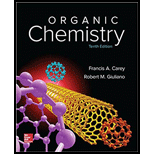
Concept explainers
Interpretation:
Structural formula for the major product for alkyl bromide, when each of the given alcohols is reacted with hydrogen bromide, is to be drawn using the same format for alkyl bromide as the original given alcohol. IUPAC name for each alkyl bromide including its stereochemistry is to be given.
Concept introduction:
Secondary and tertiary alcohols react with hydrogen halides by the
Primary alcohols and methanol react with hydrogen halides by the
There is a possibility of a formation of a racemic mixture to give a mixture of stereoisomers when optically active alcohols react with hydrogen halides in an
There is an inversion of configuration for the reaction of optically active alcohols with hydrogen halides in an
The three dimensional spatial arrangement of substituents at a chirality center is called the absolute configuration.
The Cahn-Ingold-Prelog rule system ranks the substituents in the chirality center in the order of decreasing
In next step, molecule is oriented such that the bond to the lowest ranked substituent points away from the observer. Then check the path of sequence of decreasing priority. If the path of sequence of decreasing priority is clockwise then the configuration is R and if path of sequence of decreasing priority is anticlockwise, then the confirmation is S.
Trending nowThis is a popular solution!

Chapter 5 Solutions
ORGANIC CHEMISTRY-W/STUD.SOLN.MAN.
- Hi, I need your help i dont know which one to draw please. I’ve attached the question along with my lab instructions. Please use the reaction from the lab only, as we are not allowed to use outside sources. Thank you!arrow_forward5. Write the formation reaction of the following complex compounds from the following reactants: 6. AgNO₃ + K₂CrO₂ + NH₄OH → 7. HgNO₃ + excess KI → 8. Al(NO₃)₃ + excess NaOH →arrow_forwardIndicate whether the product formed in the reaction exhibits tautomerism. If so, draw the structure of the tautomers. CO₂C2H5 + CH3-NH-NH,arrow_forward
- Draw the major product of this reaction N-(cyclohex-1-en-1-yl)-1-(pyrrolidino) reacts with CH2=CHCHO, heat, H3O+arrow_forwardDraw the starting material that would be needed to make this product through an intramolecular Dieckmann reactionarrow_forwardDraw the major product of this reaction. Nitropropane reacts + pent-3-en-2-one reacts with NaOCH2CH3, CH3CHOHarrow_forward
- Indicate whether the product formed in the reaction exhibits tautomerism. If so, draw the structure of the tautomers. OC2H5 + CoHs-NH-NH,arrow_forwardExplain how substitutions at the 5-position of barbituric acid increase the compound's lipophilicity.arrow_forwardExplain how substitutions at the 5-position of phenobarbital increase the compound's lipophilicity.arrow_forward
- Name an interesting derivative of barbituric acid, describing its structure.arrow_forwardBriefly describe the synthesis mechanism of barbituric acid from the condensation of urea with a β-diketone.arrow_forwardGiven the hydrazones indicated, draw the structures of the enamines that can be formed. Indicate the most stable enamine (explain). C6H5 C6H5 H C6H5 Harrow_forward
 Organic ChemistryChemistryISBN:9781305580350Author:William H. Brown, Brent L. Iverson, Eric Anslyn, Christopher S. FootePublisher:Cengage Learning
Organic ChemistryChemistryISBN:9781305580350Author:William H. Brown, Brent L. Iverson, Eric Anslyn, Christopher S. FootePublisher:Cengage Learning
